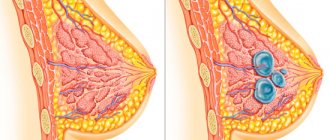Oncologist-mammologist is a doctor who diagnoses, treats and prevents malignant tumors of the mammary glands. This specialist knows what to do if an unknown lump appears in the breast, how to distinguish a malignant neoplasm from a benign one, and how to treat breast cancer in the early stages.
At the European Clinic you can receive all types of medical care, which is within the competence of oncomammamologists:
- Consultation and examination. To make an appointment, you can contact us at any time, we work 24/7.
- A second medical opinion in difficult cases, when there is doubt about the diagnosis, if the previously prescribed treatment has ceased to help.
- A complete examination using modern equipment, which will help establish an accurate diagnosis and clarify the stage of cancer.
- All types of surgical treatment.
- Treatment with modern antitumor drugs: chemotherapy, targeted therapy, hormonal therapy. Our doctors work in accordance with American and European protocols. We undertake cancer treatment at any stage, including if the patient could not be helped in another clinic.
- All types of palliative treatment. Effective pain relief.
- If necessary, emergency hospitalization in the intensive care unit.
Mammologist: what does this specialist treat?
The activity of a mammologist consists of carrying out a number of activities aimed at diagnosing, preventing and treating multiple ailments of the mammary gland, dishormonal pathologies of the mammary glands associated with hormonal imbalances. This category of diseases includes:
- Fibrocystic disease, or otherwise mastopathy, this type of disease in the form of lumps in the breast is the most common pathology of the mammary gland;
- Hypomastia – insufficient development of the mammary glands;
- Hypermastia – swelling of the mammary glands, accompanied by painful sensations;
- Gynecomastia – enlargement of the breast in men;
- Galactorrhea is the spontaneous release of milk in nursing women.
Tumor pathologies of the mammary glands. This type includes:
- Breast cancer;
- Lipoma;
- Fibroadenoma;
- Sarcoma;
- Echinococcosis.
Inflammatory processes occurring in the mammary glands. This classification includes:
- Mastitis;
- Actinomycosis;
- Tuberculosis and syphilis of the mammary glands.
- Inflammatory diseases are often accompanied by purulent formations, the treatment of which is also within the competence of doctors specializing in purulent surgery.
What types of treatment are performed by oncologists-mammologists at the European Clinic?
Our doctors perform all types of surgical interventions. We try to adhere to the most careful approach possible and, whenever possible, perform organ-preserving interventions in cases where they are appropriate and do not increase the risk of relapse.
We have access to all modern chemotherapy drugs, hormonal and targeted drugs. Our oncomammologists prescribe them according to modern international protocols. We know how to correctly prescribe treatment for advanced breast cancer, prolong the patient’s life as much as possible and keep symptoms under control.
When to go to a mammologist: preventive, first and urgent examination
An important rule for maintaining health is a preventive examination by a mammologist twice a year, since pathological processes in the mammary glands in women can begin asymptomatically. For women who have reached the age of thirty, in the absence of unpleasant symptoms and predisposing hereditary factors contributing to the development of breast diseases, visits to a mammologist can be reduced to once every year and a half. But every woman should remember that breast tumors often appear without visible symptoms. Many female representatives conduct independent examination of the mammary glands by palpation, believing that they will be able to detect abnormal changes in time. But this opinion is wrong. Only a professional approach, including multiple examination methods, will identify the disease at the initial stage.
Also, visiting a mammologist is mandatory for women planning a pregnancy, carrying a child and breastfeeding. Since pregnant and lactating women are among the categories of people most susceptible to developing breast diseases due to hormonal changes.
Not only adult women, but also young girls should undergo regular visits to a mammologist for preventive purposes, since timely diagnosis of existing breast anomalies will allow treatment to begin at an early stage and, accordingly, to avoid the development of complications that pose a threat to health and life. Therefore, the first visit to a specialist should be done at a young age.
If suspicious signs appear in the form of redness, discharge, pain, lumps and other unpleasant symptoms in the chest area, examination and consultation with a specialist should be carried out urgently.
A visit to a mammologist has some peculiarity - you need to go to see him after the end of menstruation or five to six days before the start of ovulation. This is because data from studies conducted during the menstrual cycle may show erroneous results.
When to see a mammologist
The following symptoms are a reason to visit a mammologist as soon as possible:
- Chest pain. It can be cyclical, or it can be present constantly.
- Painful sensations when touching the breast.
- Seal detection.
- The presence of discharge from the nipple outside of pregnancy and breastfeeding. Bloody discharge should be especially alarming.
- Changes in breast shape, size and surface relief.
- Changes in the size of the axillary lymph nodes.
- Changes in the skin of the breast and nipple.
In addition, it is recommended to undergo preventive examinations with a mammologist at least once a year. After 35 years, it is recommended to perform an ultrasound of the mammary glands annually, and after 40, mammography every two years. It is also worth visiting a doctor if you are planning a pregnancy, or vice versa, contraception using hormonal drugs.
As part of the diagnosis of diseases, an examination is carried out with physical examination methods (palpation) and instrumental examination, which may include the already known ultrasound and mammography, as well as, according to indications, CT, MRI, PET, etc. In addition, laboratory diagnostics are carried out with the determination of hormonal profile.
After 35 years, it is recommended to perform an ultrasound of the mammary glands annually, and after 40, mammography every two years.
Mammography is an x-ray method for examining breast tissue. It allows you to detect a malignant neoplasm long before its clinical manifestation. Regular mammography is included in breast cancer screening programs in countries where these programs have been adopted.
If cancer is suspected, the patient is referred to a specialized specialist, an oncologist-mammologist who is skilled in invasive diagnostic methods. For example, he may perform a biopsy for cytological or histological diagnosis. Today this is the only method that makes it possible to make a morphological diagnosis of malignant breast tumors.
Examination by a mammologist: when does it become necessary?
There are many pathological conditions of the mammary glands, the presence of which should be treated with caution and seek mandatory consultation with a doctor.
These are specific symptoms whose presence should cause serious concern, namely:
- Redness of the skin in the chest area;
- A sharp increase or decrease in breast size;
- Asymmetry of the mammary glands;
- Feeling of fullness and swelling of the mammary gland;
- Lumps in the chest;
- Nipple discharge;
- Cracked nipples;
- Pain syndrome in the armpit area;
- Painful sensations in the chest;
- Swelling or retraction of the skin near the nipples.
In addition to the listed signs, there are a number of predisposing factors, in the presence of which one should not neglect the consulting assistance of a mammologist:
- Diseases of the genitourinary system (both currently present and suffered in the past);
- Pregnancy, especially accompanied by certain unpleasant sensations in the chest area;
- Breastfeeding, refusal to breastfeed, or holding the baby to the breast for too long;
- Difficult childbirth, resulting in multiple complications;
- Frequent abortions and miscarriages;
- Early puberty, in particular menstruation starting before age 11;
- Menstrual irregularities, which also include menopause;
- Previous injuries to the mammary gland (impacts, burns, etc.);
- Liver diseases;
- Increased nervousness, psycho-emotional states, prolonged stress and depression;
- Hereditary factors, that is, the presence of breast diseases in close relatives;
- Disruption of the endocrine system (diabetes, thyroid disease);
- Taking hormonal drugs;
- Sexual dissatisfaction or lack of sex life;
- Alcohol abuse and smoking.
The presence of the considered risk factors requires a thorough examination, including various diagnostic methods, based on the results of which the mammologist will prescribe appropriate preventive measures or treatment.
Mammologist appointment: how does it happen?
This specialist’s appointment involves palpation (that is, palpation of the mammary glands), as well as identifying specific complaints that are relevant to the patient. The following options can be assigned as research methods through which subsequent diagnosis of pathology can be made:
- mammography (as part of this study, the mammary glands are examined using x-rays);
- ultrasound examination (ultrasound) of the mammary glands;
- examination of tissues removed by biopsy for subsequent oncological analysis of the material.
Additionally, the following methods can be used:
- scintigraphy;
- CT and MRI of the chest;
- ductography (a method of x-ray examination of the ducts of the mammary glands).
Tests prescribed by a mammologist
When you contact a mammologist, after a mandatory examination and palpation, you will have to undergo some tests that will help in establishing a diagnosis.
First of all, if there is any discharge from the nipple, you will need to take a smear and send it for cytological examination.
Cytological diagnostics consists of a quantitative and qualitative study of cell composition. Atypical (irregular) cells identified in this way may indicate a disease.
You will also need:
- Clinical blood and urine tests;
- Blood test for tumor markers;
- Blood test for changes in the functioning of the endocrine system and deviations in hormonal levels.
If necessary, a diagnostic puncture may be necessary. It is necessary when nodules, lumps or other formations are detected in the mammary gland. If, upon examination and palpation, a mammologist reveals a change in the color and structure of the skin on the chest, or discharge that is bloody or yellowish in color, then a diagnostic puncture is required, since in this case we may be talking about cancerous processes. The purpose of the puncture is to determine whether the formation is benign or malignant. The doctor first assesses the size and shape of the tumor, usually using ultrasound or mammography. A week before the diagnostic puncture, you should not take aspirin and anticoagulants.
What happens at an appointment with a mammologist
The mammologist begins the appointment with an examination and thorough palpation of the breast, that is, he thoroughly palpates it. After the examination, the doctor finds out what is bothering the patient. For a clearer diagnosis, the doctor gives a referral for additional studies that will help make an accurate diagnosis:
Ultrasound
mammography
biopsy
- mammography (breasts are examined using x-rays);
- Ultrasound of the mammary glands;
- checking affected tissues taken by biopsy for analysis for cancer.
If the situation is sufficiently advanced, the doctor writes a referral for additional examination. Such procedures include:
- scintigraphy;
- MRI and CT;
- ductography (examination of ducts in the mammary glands).
ductography
MRI
In addition to the procedures, the oncologist-mammologist can issue a referral for certain tests that will help determine the nature of the emerging disease. Such procedures include:
- taking swabs from the nipples (or from one) and examining this material;
- puncture from neoplasms.
What diagnostic methods does a mammologist use?
When determining a diagnosis, a mammologist uses the following diagnostic methods:
- Palpation. As a rule, diagnosis should be carried out in the middle of a woman's menstrual cycle. First of all, the doctor visually assesses the condition of the mammary glands (color, structure). Then he immediately begins to palpate the mammary gland. Diagnosis is carried out in a standing position, and then lying on your back, with your arms thrown back behind your head. During palpation, the condition of the nipples is assessed. The examination begins in a standing position, each breast is palpated in turn, then the condition of both is assessed simultaneously (with both hands). Then the patient lies on her back, since in a supine position it is easier to determine the formation and its mobility than in a vertical position. Palpation of the breast can reveal hypertrophy, cysts, tumors, but an accurate diagnosis can only be made using this diagnostic method in case of pronounced manifestations of the disease (inflammation, lipoma, papilloma). All formations of a different nature in the thickness of the mammary gland require additional diagnostics.
- Mammography. Diagnosis consists of examining the mammary gland using weak X-rays. The purpose of mammography is to detect cancer at an early stage. Like any x-ray test, mammography takes a series of images, which are then analyzed by radiologists. Pathological formations can be seen on x-rays.
- Ultrasonography. Ultrasound is used as an additional diagnostic method, along with mammography. Diagnostics are usually prescribed for further examination of lumps or formations identified on mammography or palpation.
- Ductography. A method that examines nipple discharge if mammography is insufficient.
- MRI (magnetic resonance imaging). A fairly effective research method for questionable formations, as well as for examining patients diagnosed with breast cancer immediately before surgery. For cancer patients, this method is necessary to identify new formations that may affect the course of the operation.
- CT scan. It is prescribed to determine the size of the tumor, whether it should be removed or not due to growth into the chest. The research method consists of taking a series of x-rays, which are then processed by a computer.
- Thermomammography. This is a modern research method in which a special device detects infrared radiation and tissue temperature in the mammary gland, which is a consequence of pathological cell proliferation. This process makes it possible to examine the cancer process long before the tumor begins to form. The method is absolutely harmless and is intended for the initial examination of women. Such an examination can be carried out once a year, during preventive examinations.
Are you looking for a good oncologist-mammologist?
The doctors of the European Clinic are experts who have extensive experience working in the best clinics. They actively collaborate with foreign colleagues; many have undergone internships abroad.
| More information about breast cancer treatment at the European Clinic: | |
| Consultation with an oncologist-mammologist | from 5100 rub. |
| Surgeons-oncologists-mammologists | from 5100 rub. |
| Removal of a breast tumor | from 92,000 rub. |
| Emergency oncology care | from 11000 rub. |
If you need the help of an experienced oncologist, we are available 24 hours a day, 7 days a week.
We know how to help. Book a consultation around the clock +7+7+78
Pediatric mammologist
We have already highlighted the need to visit a mammologist at an early age above; in fact, a pediatric mammologist is a specialist whose visit is necessary for a child or adolescent to treat certain conditions and diseases. These include pseudotumor formations, asymmetry of the glands, injury to the glands or their hypertrophy (enlargement). This is also an age-related fibroadenoma, etc. Let us repeat that with a timely visit to a mammologist, the possibility of a complete cure is possible with the implementation of adequate therapy measures.
In adolescence, consultation with a mammologist is necessary during the period of the so-called “hormonal storm”, because diseases of the mammary glands often begin to develop precisely from this period, and their manifestation can be noted already during pregnancy or lactation (breastfeeding).
It should be noted that a pediatric mammologist must partly also be a psychologist, taking into account the characteristics of the child’s psyche and the psyche of adolescents. The ability to establish contact and inspire trust on the part of patients is important. Taking this into account, a mammologist, reviews of whom are often the best confirmation of compliance with the requirements regarding professionalism and treatment, must be selected carefully, that is, again, taking into account qualifications, the effectiveness of treatment, and attitude towards patients.
Common Myths
Today, breast cancer is not a death sentence. The initial stages of the disease are completely cured, after which the woman can become pregnant, give birth, breastfeed her children and live a full life. The main thing is to consult a doctor in time and get rid of the myths associated with breast cancer.
Myth One: Most breast lumps are malignant.
This is wrong. In more than 80% of cases, nodules found in the breast are associated with benign formations, such as cysts.
Myth two: Breast augmentation with implants can cause cancer.
According to studies, no connection was found between the installation of implants in the mammary glands and cancer.
The third myth: if the breasts are small, they are not at risk of benign formations and cancer.
Unfortunately, any disease of the mammary glands can occur even in those women who have very small breasts.
The fourth myth: breast cancer always manifests itself in the appearance of a solid formation.
In fact, an oncological disease can manifest itself as irritation on the skin, retraction of the nipple, swelling of the lymph nodes, or even be asymptomatic at first.
Breast cancer: symptoms
Considering that breast cancer is perhaps one of those major diseases that women are especially afraid of, it is important to know what symptoms appear with it at the obvious stages of its relevance, that is, when, in general, any phenomena have already otherwise, but they make themselves felt.
So, first of all, it is pain. An important fact is that from time to time women, one way or another, encounter pain in this area. If chest pain occurs frequently, it can be assumed that hormonal changes are the cause of this phenomenon (in up to 90% of cases this is exactly the case). With pain in only one of the mammary glands, as well as with the appearance of discharge in the same gland, with engorgement of the skin and with the detection of a tumor formation during palpation, we can say that the symptoms manifested in a particular case look somewhat more serious than just pain in the breast. breasts
Pain in the armpits, pain in the nipple area - these manifestations occur in approximately 10% of cases in women during the premenstrual period. The pain that appears in this case is characterized as dull. To relieve pain, you should reduce the amount of salt in your diet a few days before your period begins, and you should also avoid drinks that contain caffeine during this period. Due to this, fluid removal from the body will occur unhindered; breast tissue is also no exception.
If you have undergone a previous biopsy procedure or with a previous injury, the pain is of a slightly different nature. Thus, the concentration of pain is noted in a specific area, without connection with the menstrual cycle. The nature of the pain is cutting or shooting. It should be noted that after a biopsy, pain can persist for up to two years, the pain is concentrated mainly in the chest, although the main focus of pain is concentrated in the ribs. If the pain increases with a deep sharp breath or when pressing on the ribs, there is reason to assume that the patient has nothing more than arthritis.
Stress in pain also has its own position in terms of the manifestation of symptoms. So, if the level of stress hormone in the body is increased, then the pain in it also increases, regardless of the area of their localization; accordingly, this is also true for the mammary glands. If you add this to the influence of alcohol, coffee and poor diet in combination with your daily routine, you will soon notice that pain in the chest increases.
The next symptom that you should pay attention to in the context of this disease is the appearance of discharge. Although discharge may be alarming, in reality it has nothing to do with cancer in most cases. Basically, this is a normal phenomenon, relevant for the second part of the menstrual cycle; the reason for their occurrence is the accumulation of a certain amount of fluid in the area of the milk canals. If pregnancy does not occur, this fluid disappears over time. It should be noted that the excited state of the nipples can lead to the release of a small amount of this fluid; it is mostly either transparent or slightly cloudy. Sometimes such discharge occurs against the background of undergoing significant physical activity.
Despite the fact that discharge is not a direct indication of actual breast cancer, certain features of it should nevertheless raise suspicion:
- the constant nature of the discharge (that is, it appears not only in the period of several days preceding menstruation);
- the discharge is accompanied by external changes in the mammary glands (palpation of lumps, engorgement of the skin);
- the appearance of a spontaneous type of discharge (that is, discharge appears without prior compression of the chest, without previous physical activity or friction);
- the liquid released from the nipples has a certain color (that is, it is not cloudy or transparent, but reddish, greenish, etc.);
- the nipple skin itches and is generally inflamed;
- discharge is noted from only one breast or discharge is noted from 1-2 pores in the nipple.
The lumps that we have already noted are in many cases not malignant, but this is not a reason to exclude them as a serious symptom indicating possible breast cancer, quite the contrary. In particular, a visit to a mammologist may include the following symptoms associated with a lump in the breast:
- when palpated, the hardness of the seal is noted;
- the edges of the seal are uneven; it is characterized by pain;
- there are no similar lumps in the other breast;
- the movement of the compaction occurs only with the tissues adjacent to it;
- the features inherent in compaction do not change in accordance with the menstrual cycle.
Diagnostics:
Diagnosis in KME begins with a careful history taking. Our specialists are confident that the history of the disease and analysis of the patient’s complaints are the key to correct diagnosis.
The doctor pays attention to the nature of the pain, the time of its onset and end, and the connection of these periods with the menstrual cycle.
After collecting an anamnesis, palpation is performed, which allows a preliminary assessment of the density and uniformity of breast tissue, to suggest the presence of tumors, and to identify the presence of discharge from the nipples.
At the stage of instrumental diagnostics, patients are prescribed ultrasound of the mammary glands, and, if necessary, digital mammography with tomosynthesis. If there are absolute contraindications for x-ray examination, the clinic has an electrical impedance mammograph, although this diagnostic method is considered less accurate. The doctor coordinates diagnostic methods with the patient, selecting the necessary set of diagnostic measures depending on the data obtained during the examination and history taking.
Our specialists themselves are proficient in functional diagnostic methods, which in many cases allows us to combine the initial appointment with instrumental research. This means the doctor will be able to collect most of the data immediately during the initial appointment.
The Medical Examinations Clinic has its own laboratory. Our specialists prescribe laboratory blood tests to determine the presence and stage of the inflammatory process, the presence of malignant neoplasms using specific tumor markers.
Advice from a mammologist
Every mammologist warns about risk factors that may lead to problems in the mammary glands in the future. The main danger is that malignant tumors may later form at the site of injury. Therefore, you need to try to protect your chest from blows, bruises, etc. If injury could not be avoided, you should definitely consult with a mammologist; perhaps he will consider it necessary to undergo a more complete examination.
Infections. Frequent inflammatory processes in the female reproductive system lead to hormonal imbalance. The breasts react immediately to any hormonal changes. Soreness, swelling of the mammary glands before menstruation, the appearance of nodules - all this occurs as a result of hormonal imbalance. Ultimately, this leads to mastopathy.
Pathology in the mammary gland occurs from an infection that is transmitted from the genital organs; it can remain in the body in a “dormant” state until the favorable time comes for its development. Chronic inflammation in the mammary gland, which tends to acquire a malignant form, poses a great danger.
Late birth. The first pregnancy, which occurs after 30 years, contributes to the development of cancerous tumors in the mammary gland. Most likely, the reason for this is poor ecology and exposure to toxic substances contained in city air. As a result of external factors, the cells’ ability to respond normally to the hormonal surge that invariably accompanies pregnancy is weakened.
Oral contraception. Many studies have been conducted in this area and it has been proven that oral contraceptives do not provoke cancerous tumors in the mammary gland. However, it has also been proven that long-term use of birth control pills (more than four years) in nulliparous women can lead to the development of malignant tumors. Therefore, girls who have not yet given birth should find another method of contraception and not abuse oral contraception.
Radiation. According to doctors, radiation to which a woman under 30 is exposed provokes cancer in the mammary gland. An X-ray examination, which is usually prescribed no more than once a year, has a dose that is safe for humans, but still the doctor must record the radiation dose in the medical record each time so that the maximum threshold is not exceeded in the future.
Ultraviolet. The skin in the chest area is very delicate, thin, and easily vulnerable. The mammologist recommends sunbathing (sunbathing) in the morning (before 10.00) or evening (after 16.00). If it so happens that you find yourself in the sun at noon, then you need to protect your chest with a special sunscreen with a high filter.
Diet. The main cause of problems in the mammary gland is primarily a hormonal imbalance in the body. There are some foods that increase estrogen levels. You should avoid smoked, fatty foods, replacing them with vegetables, cereals, and citrus fruits. There is evidence that breast pain before menstruation is caused by foods high in methylxanthine (coffee). Replacing your morning coffee with a cup of tea (preferably green) will reduce breast soreness.
The mammologist warns that a systematic preventive examination is the main method for early diagnosis of pathological processes in the breast. All questions and problems can be discussed at an appointment with a qualified doctor, and you can receive all the information about prevention, possible risks and complications.
Medical specialties
Phlebologist
Neurologist
Psychotherapist
Cardiologist
Gynecologist
Orthodontist
Orthopedist
Consultation with a mammologist in Nizhny Novgorod.
An appointment with a mammologist begins directly with an analysis of the medical history. An important role in analyzing the causes of mastopathy is played by information about previous diseases, the nature of menstruation, the number of births and abortions, genetic predisposition and some other factors. Then the complaints, the approximate time of onset of symptoms, their connection with the menstrual cycle, the presence of characteristic discharge from the nipples, as well as their consistency, consistency, and color are clarified.
A clinical examination by a mammologist consists of examination and manual examination, during which the shape, condition of the nipple, and skin are studied. Not only superficial, but also deep palpation of the lymph nodes is performed. At the same time, the doctor examines their condition, including the presence of seals. Special attention is paid to nodal formations.
The mammologist charges low prices, so his services are available to everyone.
Diagnosis of small tumors (less than 1 cm) by ultrasound is very effective (more than 90% of cases detected).
Mammologist - the second female doctor
One day, as part of my journalistic “service,” I ended up in a factory that made lingerie. I was taken through the production, shown yards of French lace, English embroidery, Italian silk and... stacks of shoulder pad-like “prosthetics” that some women are forced to put in bras instead of their own breasts. Out of surprise, I tried to joke. “There’s no need to smile,” the factory director gently stopped me, “you apparently don’t understand the scale of the tragedy...”
Don't worry – be happy
“All illnesses come from nerves,” we say both jokingly and seriously. But this is actually true for the “onset” of many diseases. One of which is mastopathy. Experts say that mastopathy is one of the most common female diseases, and that about 80% of women suffer from it. There is no need to panic, mastopathy is a benign disease, a disorder of the structure of breast tissue, depending on the hormonal background of the body, and specifically on the level of progesterone, the fluctuations of which directly depend on the emotional state. To put it simply, the more often and more nervous we are, the more likely mastopathy is. Ladies who smoke, those who take hormonal drugs, “carry” extra pounds, have an irregular sex life and suffer from inflammation of the appendages need to be even more attentive to themselves. The frightening list can be continued for a long time, but the main thing that doctors warn us against is stress.
Hurts? This is good!
It is recommended to visit a mammologist at least once every six months. And in the intervals between visits to the doctor, you need to examine yourself. Raise your arm bent at the elbow and feel your chest with your other hand. Conditionally dividing it into four parts, carefully examine each quarter. What are we looking for? Seals, changes in the skin - too smooth or, on the contrary, wrinkled areas. If you notice some kind of transformation, or something similar to a ball rolls under your fingers, and painful sensations appear when pressed, immediately go to the doctor. But you shouldn’t be scared ahead of time - malignant tumors do not cause pain, which means unpleasant sensations are a good sign. But neglect leads to breast cancer. Not so long ago, only one way to combat this disease was known - the so-called Halstead operation, in which the breast tissue, that is, the breast itself, was removed completely, down to the ribs. Fortunately, medical science does not stand still and the “bloodthirsty”, but the only reliable method at that time, was replaced by a more modern one - radical resection, in which only the node and a small amount of affected tissue are surgically removed. As a result, the patient is left with a small scar, which, as a rule, is easy to hide with a swimsuit, and which, of course, is not visible under clothing. As a result, only three people know about this little secret: the lady who underwent the operation, her doctor and her husband. But if the problem is detected in a timely manner, even this measure can be avoided.
Not a woman's disease
Despite the fact that mastopathy is considered to be a female disease, the stronger sex also has mammary glands. This means that “problems” cannot be ruled out. In men, this is called gynecomastia. Young people during puberty, which means a hormonal explosion, and men at the turn of forty are susceptible to this scourge. After forty years, men, like women, are at risk of developing breast cancer. Monitoring the health of dear men is usually a woman's concern. Mothers of growing sons and wives need to be attentive... although wives always need to be attentive.
Trust the experts
I would like to warn girls and women both from self-medication and from “newfangled” research methods. In the first case, you expose yourself to serious danger - after all, only a doctor who has the results of a thorough and most complete examination can prescribe the correct therapy. And “new methods” are, unfortunately, an attempt to reinvent the wheel. Classic mammography provides a 100% diagnosis, and for young women (up to 35-40 years old), an ultrasound examination is often sufficient - modern ultrasound machines have a fairly high resolution. After forty years, breast tissue changes and mammography, that is, an X-ray, becomes necessary for accurate diagnosis.
Where to go for treatment
Since the problem of mastopathy is very common, then, according to the principle “demand generates supply,” a lot of medical and, most dangerously, paramedical centers offer millions of treatment methods - from homeopathy to spells, often without even conducting basic diagnostics. God forbid you get involved with charlatans and ruin your health for your own money. “A proper examination,” says Dmitry Evgenievich Levshukov, Ph.D., a mammologist from the Scandinavian Medical Center, “should begin with an examination by a mammologist. But a visual inspection alone is not enough. It is imperative to have a mammogram and ultrasound examination of the breast. After all, small changes - non-palpable breast tumors, that is, the early initial signs of breast cancer, including accumulations of microcalcifications in the breast tissue - can only be seen on mammograms. Ultrasound helps complete the picture and is quite sufficient for a routine examination every six months.
When choosing a clinic (and, accordingly, a doctor), pay attention to the fact that all examinations are concentrated in one person. One doctor should conduct an appointment, do an ultrasound, mammography and, if necessary, take smears of discharge and perform a puncture. This will help avoid mistakes. “Treatment of mastopathy is a rather labor-intensive process,” says Dr. Levshukov. — The patient should be observed by a gynecologist, endocrinologist (the thyroid gland must be examined), the liver needs to be checked and a visit to a psychotherapist is required. This whole complex is necessary to avoid the development of mastopathy into breast cancer. A multidisciplinary medical center, in which all specialists are, so to speak, under one roof, as we have in the Scandinavian Medical Center, can seriously simplify the task. In addition, we have our own mini-mammology center with the equipment and laboratory necessary for the entire cycle - from diagnosis to surgery.
Irina Sorokina
Department of Mammology
Make an appointment:
- +7 call center
- +7 WhatsApp, Viber
- Online application
At our clinic, we perform a sentinel lymph node biopsy during mastectomies, which helps prevent unnecessary lymph node removal in patients with breast cancer. Read more…
You can also take a test to detect mutations in the BRCA1 and BRCA2 genes - this procedure allows you to diagnose a high risk of breast cancer. Read more…
Mammology specializes in the treatment, diagnosis and prevention of breast diseases. Pathologies of this paired organ appear as a result of hormonal imbalances, constant stress, mechanical damage, against the background of endocrine and gynecological diseases. Hereditary factors play an important role in the development of mammological diseases. The severity of the clinical picture depends on the stage of the disease, its type, and the individual characteristics of the patient. Often a woman is not aware of the formation of a tumor in the breast or inflammation.
Department of Mammology under the leadership of S.M. Portnoy
Who are we treating?
Patients with diseases of the mammary glands:
- fibroadenoma,
- nodular mastopathy,
- intraductal papilloma,
- leaf-shaped tumor
- breast cancer.
Healthy women carriers of mutations in breast cancer susceptibility genes.
About Frau Klinik Mammology Clinic
The Frau Klinik Mammology Clinic is one of the leading private breast cancer centers in Russia. The Mammology Center is headed by the leading oncologist-mammologist of Russia, recognized by the world mammology community, S.M. Tailor. Our clinic presents the most modern medical equipment and the entire range of the best original drugs and techniques used in the treatment of diseases of the mammary glands. Our doctors provide a full range of medical services, including early diagnosis of breast cancer, surgical treatment (including breast-conserving surgery), chemotherapy and rehabilitation. We guarantee treatment of breast diseases in accordance with modern American and European quality protocols.
At the Frau Klinik breast center in Lefortovo:
- You can undergo a full breast examination;
- take a molecular genetic blood test for mutations of the BRCA1 and BRCA2 genes;
- develop a treatment plan and receive a detailed consultation with leading oncologist-mammologist S.M. Tailor;
- also available: you can come to our clinic with your tests obtained in another clinic and receive additional consultation at a professorial level.
We work only with original, expensive drugs that guarantee the best results!
Treatment methods:
1. Surgical:
- Bilateral prophylactic mastectomy
- Removal of fibroadenoma
- Sectoral breast resection
- Organ-saving surgery for cancer
- Axillary lymph node surgery: Sentinel lymph node biopsy
- Axillary lymphadenectomy
2. Non-surgical:
- Chemotherapy
- Hormone therapy
- Immunotherapy
- Radiation therapy
- Technological advantages
- operating room
- Reports by Portnoy S.M.
Tailor Sergey Mikhailovich
Oncologist-mammologist.
Doctor of Medical Sciences. Leading Researcher. From 1975 to the present, he has been treating tumor diseases of the mammary glands at the Russian Oncological Research Center named after. N.N. Blokhin RAMS. Member of the Moscow Oncology Society.
Work experience - more than 39 years
Karpov Andrey Vladimirovich
Oncologist-mammologist.
Member of the Russian Society of Oncomammologists. Conducts diagnosis and treatment of benign and malignant breast diseases. She is working on her PhD thesis on the topic “Early breast cancer”.
Work experience - more than 6 years
Why go to a mammologist?
The reasons for contacting a mammologist are:
- pain, discomfort in the mammary glands,
- seal detection,
- feeling of heaviness,
- changes in the skin,
- unusual discharge from the nipple.
We are receiving Doctor of Medical Sciences Sergei Mikhailovich Portnoy. An oncologist-mammologist will conduct a thorough examination of the mammary glands for neoplasms and prescribe the necessary diagnostic tests. The Frau Klinik has at its disposal the latest medical equipment for detecting pathologies in mammology. Laboratory tests are necessary to determine the nature of the tumor and diagnose the inflammatory process.
Plastic surgery on the breast, which is common today, cannot be done without consulting a qualified mammologist. At the preparatory stage, the doctor carefully examines the mammary glands; if necessary, additional ultrasound and x-ray examinations are performed. Our clinic performs the following types of mammoplasty:
- decrease,
- breast enlargement,
- mastopexy (lift).
These procedures are aimed at returning the breasts to an attractive, aesthetic shape. They are usually performed after childbirth, as well as for women during menopause. Young patients most often turn to the surgeon to create curvy figures. When performing endoprosthetics, we use silicone implants, which are absolutely safe for health. They quickly take root and do not cause rejection reactions or allergies.
After surgery, constant monitoring by a specialist is necessary. In mammology, various preventive methods have been developed to accelerate the healing of wounds after plastic surgery, prevent inflammation, and relieve pain. By contacting our clinic, you can completely rely on a specialist. Doctors have many years of experience and continue to improve their skills.
Prices
Consultation and procedures
- Consultation with oncologist-mammologist, MD. (Tailor S.M.)
5 000 ₽ - Consultation with oncologist-mammologist, Ph.D. (Karpov A.V.)
2 500 ₽
- Ultrasound of the mammary glands
3 000 ₽
- Repeated breast ultrasound (within 3 months)
2 000 ₽
- Puncture of a palpable breast mass (1 mass)
1 500 ₽
- Ultrasound-guided marking of non-palpable breast lesions before surgery
10 000 ₽
- Installation of anchor needle under ultrasound guidance
14 000 ₽
- CORE biopsy* of breast formation under ultrasound guidance
15 000 ₽
- *Analysis collection from one point (in addition to the cost of analysis)
7 200 ₽
- Non-palpable targeted puncture puncture of a breast tumor under ultrasound control
4 500 ₽
- Ultrasound of soft tissues
2 500 ₽
Oncomammology
Mammary cancer
- Breast cancer prevention
- Breast cancer treatment
Mastopathy
- Mastopathy
Cystic pathologies
- Breast atheroma
Seals, components
- Lump in the chest
Pain
- Armpit pain
Additionally
- Calendar of promotions and discounts
- Clinic specialists
- Patient reviews











